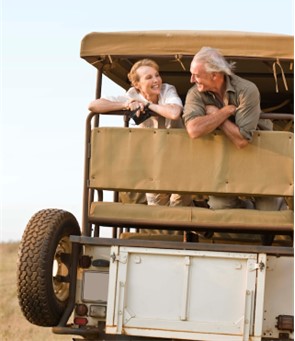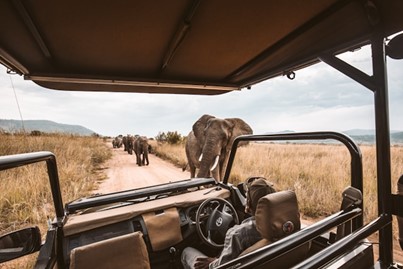Safari adventures provide an unparalleled opportunity to witness some of the world’s most magnificent wildlife in their natural habitats. These countries boast an array of parks and reserves that cater to both seasoned travelers and first-time visitors. To ensure a successful and enriching experience, thorough research and preparation are essential for these immersive trips. Below, Marcy Gendel highlights some of the best safari destinations from her experience, and lesser-known parks in South Africa and Mozambique.
South Africa: A Wildlife Haven
Kruger National Park
Kruger National Park is one of the most renowned safari destinations in the world. Spanning nearly 20,000 square kilometers, it offers diverse ecosystems and the chance to see the “Big Five” (lion, leopard, elephant, buffalo, and rhino). The park features a variety of accommodations, from luxury lodges to budget-friendly campsites.
Must-See Areas in Kruger
- Sabi Sand Game Reserve: Known for its high concentration of leopards, this private reserve within Kruger provides intimate wildlife encounters and luxurious accommodations.
- Satara Camp: Located in the heart of Kruger, Satara is ideal for spotting lions and other big cats.
Addo Elephant National Park
Located near Port Elizabeth, Addo Elephant National Park is the third-largest national park in South Africa. Initially established to protect a small number of elephants, it now supports a wide variety of wildlife, including lions, hyenas, and the endangered black rhino.
Unique Features
- Marine Section: Addo includes a marine reserve where visitors can see whales and great white sharks.
- Diverse Habitats: The park features coastal dunes, dense forests, and open savannahs, offering a unique and varied safari experience.
Hluhluwe-Imfolozi Park
Situated in KwaZulu-Natal, Hluhluwe-Imfolozi Park is the oldest proclaimed nature reserve in Africa. It is renowned for its rhino conservation efforts and offers excellent game viewing opportunities.
Highlights
- Conservation Success: Home to the largest population of white rhinos, thanks to successful conservation programs.
- Scenic Landscapes: Rolling hills and picturesque valleys make for a stunning backdrop to your safari.
Lesser-Known Gems
Marakele National Park
Nestled in the Waterberg Mountains, Marakele National Park offers breathtaking scenery and abundant wildlife, including elephants, rhinos, and a variety of bird species.
Why Visit
- Stunning Views: The park’s dramatic mountain landscapes provide a unique setting for wildlife viewing.
- Fewer Crowds: As a lesser-known destination, Marakele offers a more tranquil safari experience.
Mountain Zebra National Park
Located in the Eastern Cape, this park is dedicated to protecting the endangered Cape mountain zebra. It also hosts other wildlife, such as cheetahs, buffalo, and elands.
Special Features
- Rare Wildlife: The park’s focus on preserving the Cape mountain zebra makes it a must-visit for wildlife enthusiasts.
- Scenic Drives: The park’s well-maintained roads and trails offer excellent opportunities for self-drive safaris.

Mozambique: An Emerging Safari Destination
Gorongosa National Park
Gorongosa National Park is often hailed as one of Africa’s most incredible restoration stories. After years of conflict, the park has rebounded, and its biodiversity is flourishing.
Key Attractions
- Restoration Efforts: Learn about the park’s impressive conservation efforts that have brought back lions, elephants, and other species.
- Guided Safaris: Expert guides offer insightful tours, enhancing your understanding of the park’s ecosystems.
Niassa Reserve
Covering over 42,000 square kilometers, Niassa Reserve is one of the largest protected areas in Africa. Its remote location means it sees few tourists, providing an exclusive safari experience.
Highlights
- Remote Wilderness: The reserve’s untouched landscapes offer a raw and authentic safari experience.
- Diverse Wildlife: Home to large populations of elephants, lions, and wild dogs, Niassa is a haven for wildlife enthusiasts.
Importance of Research and Preparation
Planning Your Safari
Before embarking on a safari, it is crucial to conduct thorough research. Consider the following factors to ensure a memorable and safe experience:
Season and Timing: The best time for a safari varies by region. Research the optimal seasons for wildlife viewing in your chosen parks.
Accommodation Options: Whether you prefer luxury lodges or budget-friendly campsites, investigate the available accommodations and book in advance.
Health and Safety: Ensure you have necessary vaccinations and medications. Familiarize yourself with safety guidelines for wildlife encounters.
Guided vs. Self-Drive: Decide whether you want a guided tour or a self-drive safari. Guided tours offer expert knowledge, while self-drive allows for more flexibility.
In-Depth Research
Understanding the specific wildlife, habitats, and conservation efforts of each park will enrich your safari experience. Utilize resources such as travel guides, documentaries, and reputable websites to gather information.
Sustainable Travel
Consider the environmental impact of your safari. Choose eco-friendly lodges and support conservation initiatives to help preserve these incredible ecosystems for future generations.
Conclusion
A safari adventure in South Africa and Mozambique promises unforgettable encounters with wildlife and stunning natural landscapes. By conducting thorough research and planning, you can ensure a safe, enriching, and sustainable experience. Whether exploring the renowned Kruger National Park or the remote Niassa Reserve, the wonders of Africa’s wilderness await.
